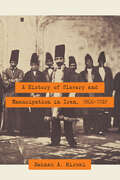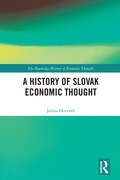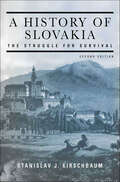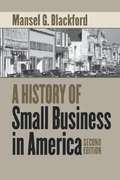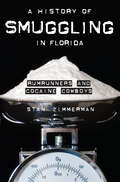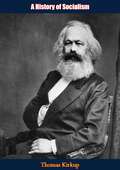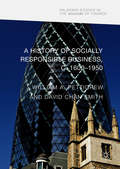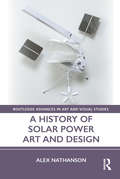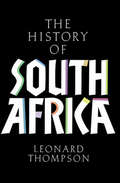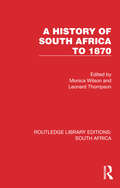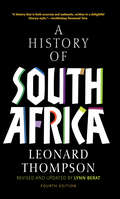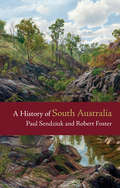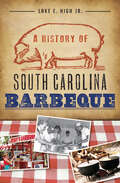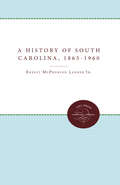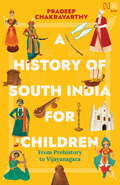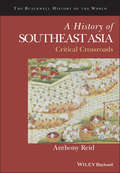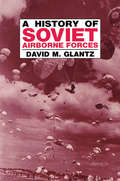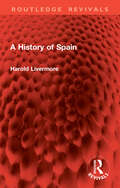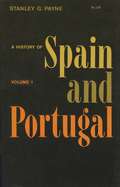- Table View
- List View
A History of Slavery and Emancipation in Iran, 1800–1929
by Behnaz A. MirzaiSlavery in the Middle East is a growing field of study, but the history of slavery in a key country, Iran, has never before been written. This history extends to Africa in the west and India in the east, to Russia and Turkmenistan in the north, and to the Arab states in the south. As the slave trade between Iran and these regions shifted over time, it transformed the nation and helped forge its unique culture and identity. Thus, a history of Iranian slavery is crucial to understanding the character of the modern nation. Drawing on extensive archival research in Iran, Tanzania, England, and France, as well as fieldwork and interviews in Iran, Behnaz A. Mirzai offers the first history of slavery in modern Iran from the early nineteenth century to emancipation in the mid-twentieth century. She investigates how foreign military incursion, frontier insecurity, political instability, and economic crisis altered the patterns of enslavement, as well as the ethnicity of the slaves themselves. Mirzai’s interdisciplinary analysis illuminates the complex issues surrounding the history of the slave trade and the process of emancipation in Iran, while also giving voice to social groups that have never been studied—enslaved Africans and Iranians. Her research builds a clear case that the trade in slaves was inexorably linked to the authority of the state. During periods of greater decentralization, slave trading increased, while periods of greater governmental autonomy saw more freedom and peace.
A History of Slavery and Emancipation in Iran, 1800–1929
by Behnaz A. MirzaiThe first history of slavery in this key Middle Eastern country and how it shaped the nation&’s unique character.Slavery in the Middle East is a growing field of study, but the history of slavery in a key country, Iran, has never before been written. This history extends to Africa in the west and India in the east, to Russia and Turkmenistan in the north, and to the Arab states in the south. As the slave trade between Iran and these regions shifted over time, it transformed the nation and helped forge its unique culture and identity. Thus, a history of Iranian slavery is crucial to understanding the character of the modern nation.Drawing on extensive archival research in Iran, Tanzania, England, and France, as well as fieldwork and interviews in Iran, Behnaz A. Mirzai offers the first history of slavery in modern Iran from the early nineteenth century to emancipation in the mid-twentieth century. She investigates how foreign military incursion, frontier insecurity, political instability, and economic crisis altered the patterns of enslavement, as well as the ethnicity of the slaves themselves. Mirzai&’s interdisciplinary analysis illuminates the complex issues surrounding the history of the slave trade and the process of emancipation in Iran, while also giving voice to social groups that have never been studied: enslaved Africans and Iranians. Her research builds a clear case that the trade in slaves was inexorably linked to the authority of the state. During periods of greater decentralization, slave trading increased, while periods of greater governmental autonomy saw more freedom and peace.&“This is a major contribution to the study of enslavement in Iran, which will doubtlessly become a must-read for any future studies of Middle Eastern and Islamic enslavement and abolition, as well as for any work on Iranian history in general.&” —Ehud R. Toledano, Tel Aviv University, author of As If Silent and Absent: Bonds of Enslavement in the Islamic Middle East&“While this book will be revelatory to scholars of Iran, it also promises to engage with theoretical trends in the study of slavery elsewhere. It frames many research questions broadly to engage with scholars of slavery in other Muslim lands, as well as slavery elsewhere.&” —Kamran Scot Aghaie, University of Texas at Austin, coeditor of Rethinking Iranian Nationalism and Modernity
A History of Slovak Economic Thought (The Routledge History of Economic Thought)
by Julius HorváthSlovakia has a rich and complex history, but until now there has not been a comprehensive analysis of the nation’s economic thought. This volume expertly fills this gap and traces the development of Slovak economic thought from the sixteenth century to the present day. Identifying key themes, moments, and thinkers, the chapters in this work consider the evolution of Slovak economic ideas and explores the nation’s place alongside other schools of thought. Significant coverage is given to the economists Gregorius Berzeviczy and Imrich Karvaš, as well as landmark periods such as the creation of Czechoslovakia, the World Wars, the Socialist regime, and post-Communist Slovakia. This book is of interest to advanced students and researchers of the history of economic thought, economic history, and political economy, as well as those with a specific interest in the history of Slovakia.
A History of Slovakia: The Struggle for Survival
by Stanislav J. KirschbaumThis classic book offers the most comprehensive and up-to-date history of Slovakia, from its establishment on the Danubian Plain to the present. While paying tribute to Slovakia's resilience and struggle for survival, it describes contributions to European civilization in the Middle Ages; the development of Slovak consciousness in response to Magyarization; its struggle for autonomy in Czechoslovakia after the Treaty of Versailles; its resistance, as the first Slovak Republic, to a Nazi-controlled Europe; its reaction to Communism; and the path that led to the creation of the second Slovak Republic. Now fully updated to the present day, the book examines the vagaries of Slovak post-Communist politics that led to Slovakia's membership in NATO and the European Union.
A History of Small Business in America
by Mansel G. BlackfordFrom the colonial era to the present day, small businesses have been an integral part of American life. First published in 1991 and now thoroughly revised and updated, A History of Small Business in America explores the central but ever-changing role played by small enterprises in the nation's economic, political, and cultural development.Examining small businesses in manufacturing, sales, services, and farming, Mansel Blackford argues that while small firms have always been important to the nation's development, their significance has varied considerably in different time periods and in different segments of our economy. Throughout, he relates small business development to changes in America's overall business and economic systems and offers comparisons between the growth of small business in the United States to its development in other countries. He places special emphasis on the importance of small business development for women and minorities. Unique in its breadth, this book provides the only comprehensive overview of these significant topics.
A History of Smuggling in Florida: Rumrunners and Cocaine Cowboys (True Crime Ser.)
by Stan ZimmermanWhy Florida has been a smuggler&’s paradise for centuries—and how traffic in everything from weapons to exotic flowers has shaped the state&’s history. Amateur smugglers may sneak a box of Cuban cigars into the U.S. here and there—but in the big picture, untaxed and untraced commerce, aka contraband, is a trillion-dollar-per-year global business. New technologies to discover and curb smuggling are met by equally well-equipped perpetrators, determined to stay below the radar. With its long coastline, hundreds of remote landing strips, and airports clogged with sun-seeking tourists, Florida is a superhighway of smuggling. It is easy to move illegal goods like weapons, drugs, slaves, exotic birds and flowers, all while avoiding the best efforts of U.S. and international customs authorities. Who does this smuggling? Well one Florida governor and the wife of another, for starters. Everyone from hardscrabble commercial fishermen, Spanish explorers, Mafia mobsters, crew chiefs for fruit pickers, respected attorneys—and even one Florida governor and the wife of another. This fascinating history covers the role of smuggling in Florida history, including its discovery and settlement, the Seminole Wars, and the Civil War. With stories of land booms, money laundering, drug runners, and more, this is a book that leaves no stone unturned—or suitcase unopened
A History of Social Justice and Political Power in the Middle East: The Circle of Justice From Mesopotamia to Globalization
by Linda T. DarlingFrom ancient Mesopotamia into the 20th century, "the Circle of Justice" as a concept has pervaded Middle Eastern political thought and underpinned the exercise of power in the Middle East. The Circle of Justice depicts graphically how a government’s justice toward the population generates political power, military strength, prosperity, and good administration. This book traces this set of relationships from its earliest appearance in the political writings of the Sumerians through four millennia of Middle Eastern culture. It explores how people conceptualized and acted upon this powerful insight, how they portrayed it in symbol, painting, and story, and how they transmitted it from one regime to the next. Moving towards the modern day, the author shows how, although the Circle of Justice was largely dropped from political discourse, it did not disappear from people’s political culture and expectations of government. The book demonstrates the Circle’s relevance to the Iranian Revolution and the rise of Islamist movements all over the Middle East, and suggests how the concept remains relevant in an age of capitalism. A "must read" for students, policymakers, and ordinary citizens, this book will be an important contribution to the areas of political history, political theory, Middle East studies and Orientalism.
A History of Socialism
by Thomas KirkupThe present book occupies, so far as I am aware, new ground among English books on Socialism. The larger historical books on the subject stop short of recent years, and leave unchronicled much Socialist thought and action of the utmost importance. My aim has been to give as briefly and fairly as possible an account of the Socialist movement over the world during the last ten years. Like everything else, Socialism has undergone a process of change, and must be studied in the works of its latest authorities. Extreme utterances of individuals have been largely disregarded.
A History of Socially Responsible Business, c.1600–1950
by David Chan Smith William A PettigrewThis book examines the changing reciprocal relationships between corporations and their various social obligations over the very long term - from the seventeenth to the twentieth century. Chapters from emerging and established business historians assess the full range of social obligations that corporations held historically. By adopting an innovative methodological approach that is long-term and comparative, this book offers a challenge to the literature on corporate history and will be of interest to researchers and academics in the field of finance and business history.
A History of Solar Power Art and Design (Routledge Advances in Art and Visual Studies)
by Alex NathansonThis book examines the history of creative applications of photovoltaic (PV) solar power, including sound art, wearable technology, public art, industrial design, digital media, building integrated design, and many others. The growth in artists and designers incorporating solar power into their work reflects broader social, economic, and political events. As the cost of PV cells has come down, they have become more accessible and have found their way into a growing range of design applications and artistic practices. As climate change continues to transform our environment and becomes a greater public concern, the importance of integrating sustainable energy technologies into our culture grows as well. The book will be of interest to scholars working in art history, design history, design studies, environmental studies, environmental humanities, and sustainable energy design.
A History of Solitude
by David VincentSolitude has always had an ambivalent status: the capacity to enjoy being alone can make sociability bearable, but those predisposed to solitude are often viewed with suspicion or pity.Drawing on a wide array of literary and historical sources, David Vincent explores how people have conducted themselves in the absence of company over the last three centuries. He argues that the ambivalent nature of solitude became a prominent concern in the modern era. For intellectuals in the romantic age, solitude gave respite to citizens living in ever more complex modern societies. But while the search for solitude was seen as a symptom of modern life, it was also viewed as a dangerous pathology: a perceived renunciation of the world, which could lead to psychological disorder and anti-social behaviour.Vincent explores the successive attempts of religious authorities and political institutions to manage solitude, taking readers from the monastery to the prisoner’s cell, and explains how western society’s increasing secularism, urbanization and prosperity led to the development of new solitary pastimes at the same time as it made traditional forms of solitary communion, with God and with a pristine nature, impossible. At the dawn of the digital age, solitude has taken on new meanings, as physical isolation and intense sociability have become possible as never before. With the advent of a so-called loneliness epidemic, a proper historical understanding of the natural human desire to disengage from the world is more important than ever.The first full-length account of its subject, A History of Solitude will appeal to a wide general readership.
A History of South Africa
by Leonard ThompsonA leading scholar of South Africa provides a fresh and penetrating exploration of that country's history, from the earliest known human inhabitation of the region to the present. Focusing primarily on the experiences of its black inhabitants, this richly illustrated book is essential reading for anyone wishing to understand the historical patterns behind the conflicts that rage in this troubled land.
A History of South Africa to 1870 (Routledge Library Editions: South Africa #21)
by Wilson Monica Thompson LeonardOriginally published in 1982 and based on the 1969 Oxford History of South Africa, this book discusses some of the trends in the historiography of South Africa before the beginning of large-scale mining operations in Kimberley in 1870. A deliberate attempt was made to look at the roots of South African society and to take due account of all its peoples. The book includes a survey of archaeological data, emphasizing the links between South Africa and the rest of the continent, and between the more remote and more recent past in South Africa. The lives of the hunting, herding and cultivating peoples who lived in South Africa before the advent of the Europeans. The foundation of a colonial society is described, and the expansion of that society until the 1770s. The final chapters review the relations between the peoples of the Cape Colony and the Nguni cultivators from their first meetings until about 1870 and the growth of the plural society in the Cape Colony until 1970.
A History of South Africa, Fourth Edition
by Leonard Thompson Lynn BeratA magisterial history of South Africa, from the earliest known human inhabitation of the region to the present. Lynn Berat updates this classic text with a new chapter chronicling the first presidential term of Mbeki and ending with the celebrations of the centenary of South Africa’s ruling African National Congress in January 2012. #147;A history that is both accurate and authentic, written in a delightful literary style. ”#151;Archbishop Desmond Tutu #147;Should become the standard general text for South African history. . . . Recommended for college classes and anyone interested in obtaining a historical framework in which to place events occurring in South Africa today. ”#151;Roger B. Beck, History: Reviews of New Books
A History of South Australia
by Paul Sendziuk Robert FosterA History of South Australia investigates South Australia's history from before the arrival of the first European maritime explorers to the present day, and examines its distinctive origins as a 'free' settlement. In this compelling and nuanced history, Paul Sendziuk and Robert Foster consider the imprint of people on the land - and vice versa - and offer fresh insights into relations between Indigenous people and the European colonisers. They chart South Australia's economic, political and social development, including the advance and retreat of an interventionist government, the establishment of the state's distinctive socio-political formations, and its relationship to the rest of Australia and the world. The first comprehensive, single-volume history of the state to be published in over fifty years, A History of South Australia is an essential and engaging contribution to our understanding of South Australia's past.
A History of South Carolina Barbeque (American Palate Ser.)
by Lake E. High Jr.&“The guru of &’que . . . [is] well equipped for his mission: securing South Carolina&’s rightful claim as home to the nation&’s first and best barbeque&” (South Carolina Living). South Carolina has been home to good, old-fashioned barbeque for quite a long time. Hundreds of restaurants, stands and food trucks sell tons of the southern staple every day. But the history of Palmetto State barbeque goes deeper than many might believe—it predates the rest of America. Native Americans barbequed pork on makeshift grills as far back as the 1500s after the Spanish introduced the pig into the Americas. Since the early 1920s, South Carolinians have been perfecting the craft and producing some of the best-tastin&’ &’que in the country. Join author and president of the South Carolina Barbeque Association Lake E. High Jr. as he traces the delectable history from its pre-colonial roots to a thriving modern-day tradition that fuels an endless debate over where to find the best plate. Includes photos! &“Of course, if one wants to taste the best, one needs to eat barbecue in South Carolina. As High repeatedly thumps into readers, the South, and South Carolina in particular, is home to real barbecue. Nevermind that hippie California TV-producer gobbledegook or those misguided cooking attempts by confused Northerners. Bless their hearts.&” —The Island Packet
A History of South Carolina Lighthouses (Landmarks)
by John HairrBefore radar, depth finders and satellite-guided navigation, long before the seafloor was charted with scientific precision, mariners relied on lighthouses to approach a coastline safely. South Carolina's history with lighthouses goes back nearly two and a half centuries. At Cape Romain, a windmill was converted into a lighthouse. St. Philip's Church in Charleston was converted into a beacon for seafarers to aid navigation to the Holy City. With such a long and storied past, the story of South Carolina's lighthouses is inseparable from its maritime history. Join author John Hairr as he recounts the fascinating history of these beacons that have shone above the shores of the Palmetto State.
A History of South Carolina, 1865-1960
by Ernest McPherson LanderThis vigorous and concise history combines clarity of approach with keen insights on the patterns of South Carolina politics, agriculture, industry, education, transportation, and race relations. Lander's study gathers the manifold developments of the state's last hundred years into specific problem areas with a perceptive eye for contrast and implication.Originally published in 1960.A UNC Press Enduring Edition -- UNC Press Enduring Editions use the latest in digital technology to make available again books from our distinguished backlist that were previously out of print. These editions are published unaltered from the original, and are presented in affordable paperback formats, bringing readers both historical and cultural value.
A History of South India for Children: From Prehistory to Vijayanagara
by Pradeep ChakravarthyThe Kohinoor diamond was once the eye of a Kakatiya deity.The Pandyas are counted among the world's longest ruling dynasties. Sanskrit poets spun mesmerizing verse that could be read in reverse too. Tantalizing Malabar spices flavoured the most lavish ancient Roman banquets. Make your way across south India, exploring its kaleidoscopic past and dazzling heritage, right from its first inhabitants up to the Vijayanagara Empire. Meet its royalty and courtiers, builders and sculptors, poets and authors, traders and merchants, spiritual leaders and devotees, and all the other people who went to make it a top destination of the time. Separated from the north by the Vindhya mountains and surrounded on three sides by water, southern India developed its own unique features - with outstanding rulers, incredible literature, spellbinding architecture, stunning dance forms and delicious food. Written in an easy style, by theme, and peppered with illustrations, photographs and tips for museum or monument visits, this very first history of south India for children (and their families) tells the thrilling and eventful story of the region's proud past.
A History of South Sudan
by M. W. Rolandsen Øystein H. DalySouth Sudan is the world's youngest independent country. Established in 2011 after two wars, South Sudan has since reverted to a state of devastating civil strife. This book provides a general history of the new country, from the arrival of Turco-Egyptian explorers in Upper Nile, the turbulence of the Mahdist revolutionary period, the chaos of the 'Scramble for Africa', during which the South was prey to European and African adventurers and empire builders, to the Anglo-Egyptian colonial era. Special attention is paid to the period since Sudanese independence in 1956, when Southern disaffection grew into outright war, from the 1960s to 1972, and from 1983 until the Comprehensive Peace of 2005, and to the transition to South Sudan's independence. The book concludes with coverage of events since then, which since December 2013 have assumed the character of civil war, and with insights into what the future might hold.
A History of Southeast Asia: Critical Crossroads (Blackwell History of the World)
by Anthony ReidA History of Southeast Asia: Critical Crossroads presents a comprehensive history of Southeast Asia from our earliest knowledge of its civilizations and religious patterns up to the present day. Incorporates environmental, social, economic, and gender issues to tell a multi-dimensional story of Southeast Asian history from earliest times to the present Argues that while the region remains a highly diverse mix of religions, ethnicities, and political systems, it demands more attention for how it manages such diversity while being receptive to new ideas and technologies Demonstrates how Southeast Asia can offer alternatives to state-centric models of history more broadly 2016 PROSE Award Honorable Mention for Textbook in the Humanities
A History of Soviet Airborne Forces (Soviet (Russian) Military Theory and Practice)
by David M. GlantzFor almost 70 years Soviet and Russian military theorists have been fascinated with the concept of airborne operations. Now Russian theorists tackle the problems posed to such operations by high-precision weaponry. This work, using newly released and formerly classified Soviet and East German archives, provides a detailed record of the performance of Soviet airborne forces during peace and war.
A History of Spain (Routledge Revivals)
by Harold LivermoreOriginally published in 1958, this was the first scholarly anglophone history of Spain. It covers the whole story from Spanish pre-history onwards and includes a full treatment of the various states until their fusion as a modern nation, and on through the Civil War until the late 20th Century. The book explains the origins and development of Spanish society and the special commitments which determined Spanish policies.
A History of Spain And Portugal
by Stanley G. PayneA comprehensive and up to date history of Spain and Portugal
A History of Spiritualism and the Occult in Salem: The Rise of Witch City
by Maggi Smith-DaltonAn elucidation of the Spiritualism movement in Salem in the mid-19th to the early 20th centuries. Salem, Massachusetts, is the quintessential New England town, with its cobbled streets and strong ties to the sea. With the notoriety of the Salem witch trials, the city's reputation has been irrevocably linked to the occult. However, few know the history behind the religion of Spiritualism and the social movement that took root in this romanticized land. At the turn of the century, seers, mediums and magnetic healers all hoped to connect to the spiritual world. The popularity of Spiritualism and renewed interest in the occult blossomed out of an attempt to find an intellectual and emotional balance between science and religion. Learn of early converts, the role of the venerable Essex Institute and the psychic legacy of &“Moll&” Pitcher. Historian Maggi Smith-Dalton delves into Salem&’s exotic history, unraveling the beginnings of Spiritualism and the rise of the Witch City.
